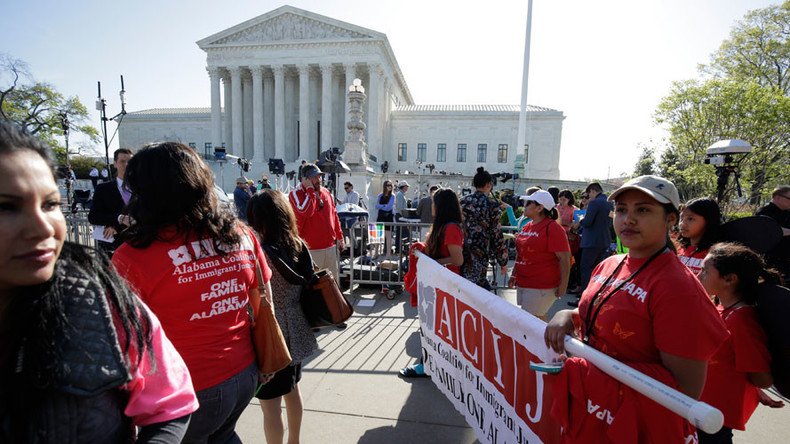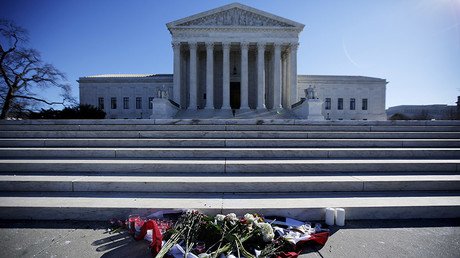Supreme Court justices clash over Obama’s immigration orders

The Supreme Court appeared equally divided as it debated President Barack Obama’s executive action on immigration, which could shield 4 million people from deportation if they are left intact. Hundreds demonstrated in support of the plan outside the court.
The seeming lack of consensus among the justices has opened the door to a possible split decision on the case, particularly since the recent death of Justice Antonin Scalia has left the court without a tie-breaking vote. If the court remains deadlocked and a 4-4 decision is rendered, a lower court ruling blocking the president’s immigration plan would remain in effect, representing a significant defeat for Obama.
In November 2014, President Obama announced executive actions that would make undocumented immigrants eligible for temporary relief from deportation. They would also be allowed to apply for legal work authorization. Altogether, roughly 4.3 million immigrants could be protected under the program.
How Obama’s executive action would impact immigrants, by birth country #Scotushttps://t.co/czDOZiPqsgpic.twitter.com/8bP5iH0jVm
— Pew Research Center (@pewresearch) April 18, 2016
However, Texas and 25 other states sued the administration over the action, calling them illegal and an “unprecedented” expansion of executive power. The Obama administration has maintained the action is legal, since the executive branch has the power to execute immigration policy.
Outside the Supreme Court on Monday, hundreds of people gathered primarily in support of Obama’s plan to shield immigrants.
Huge crowd outside #SCOTUS after immigration arguments. @CQnowpic.twitter.com/PPv0PECYhB
— Todd Ruger (@ToddRuger) April 18, 2016
During the demonstration, people shouted chants such as, “We're home and here to stay, undocumented and unafraid,” according to the Daily Mail.
Snarky protest poetry outside SCOTUS pic.twitter.com/X9i0BdRY84
— Sarah Wheaton (@swheaton) April 18, 2016
While most of the demonstrators were out in support of more lenient immigration policies, some groups were there to oppose the executive action. “We have a process in this country, and this is something the legislature should take care of,” said Kevin Mooneyhan of the Tea Party Patriots group.
During oral arguments, the questions the justices asked indicated there was “little, if any, common ground between the liberal and conservative camps on the court,” the Wall Street Journal reported.
On one side, Justice Anthony Kennedy said that it appears “as if the president is setting a policy and Congress is executing it … That’s upside down,” as quoted by Bloomberg News.
His criticism would seem to suggest sympathy for the argument opponents of the immigration plan have put forward: That Obama only issued the orders after Congress declined to change immigration law. Republicans in the House of Representatives joined the lawsuit as well, claiming it was "the most aggressive of executive power claims.”
Chief Justice John Roberts also questioned the president’s authority in this case, noting that back in 2012 Obama said he could not unilaterally protect millions of immigrants for deportation. "What was he talking about?” he asked, according to the Los Angeles Times.
On the liberal side, the justices said the orders were consistent with past executive orders by presidents. Justice Ruther Bader Ginsburg said that considering roughly 11 million immigrants in the US are undocumented, “inevitably priorities have to be set" about how to deal with them.
When questioned by the court, US Solicitor Gen. Donald Verrilli also stated that the administration is not looking to permanently grant deportation relief. He said the government is simply setting priorities, and that those with criminal backgrounds or those who entered the US recently are not protected by the executive orders.
Aside from the merits of the case, the justices also debated whether the states had a right to sue the federal government in the first place, since plaintiffs must show they are injured by a law in some way in order to have standing to sue.
The scene outside #SCOTUS before the immigration args: pic.twitter.com/PigQTxBywn
— Chris Geidner (@chrisgeidner) April 18, 2016
According to lawyers for Texas, the state can sue because it would have to pay for the drivers licenses that would be issued to immigrants who receive deportation relief under Obama’s plan. The federal government argued that Texas has chosen to pay for the licenses and could opt out if it wants to.
Even that line of thought was questioned by the conservative justices, who wondered if Texas would be involved in another dispute with the government should it choose to stop issuing licenses.
If the Supreme Court decides to throw out the case over lack of standing, Obama’s executive actions could move forward.













